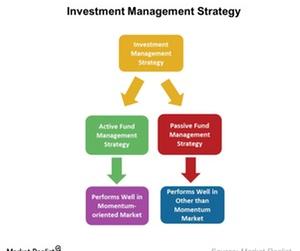How Do Active and Passive Management Strategies Compare?
Jamie Dinan spoke about the performance of the hedge fund industry in an interview with CNBC.
Oct. 31 2016, Updated 12:04 p.m. ET

Jamie Dinan’s view on active and passive management styles
Jamie Dinan spoke about the performance of the hedge fund industry in an interview with CNBC. He also highlighted various fund management styles such as active fund management and passive fund management.
Overall, hedge funds averaged 4.2% in 2016 as of September 2016. The S&P 500 Index (SPY) returned 6.1% during the same period. The S&P 500 Index (IVV) (VOO) is beating hedge fund performance. In the hedge fund industry, the passive management style is gaining more importance in the current situation.
Momentum-oriented market
In David Einhorn: What’s Driving Investment Sentiment, we saw that the passive fund management style is becoming more popular in the current market environment. This style performs well when there is a momentum-oriented market. In other words, when the stock performs well and delivers a good return, its weight in the index (QQQ) (SPY) rises. Stocks that don’t do well see their weight in the index (VFINX) (VOO) (IWM) fall and are sometimes replaced with stocks that are doing well.
When there is a momentum-oriented market, the passive fund management strategy does well. When there is a different scenario, the active fund management strategy does well. In September, total US funds inflows into funds with passive strategies was $12 billion. Funds with active management strategies saw outflows of $24 billion.
Jamie Dinan also said that the market mispriced the risk due to quantitative easing (or QE). According to him, the zero-rate environment created a major problem for the market.
In the next part of this series, we’ll analyze Jamie Dinan’s view on fiscal spending.
